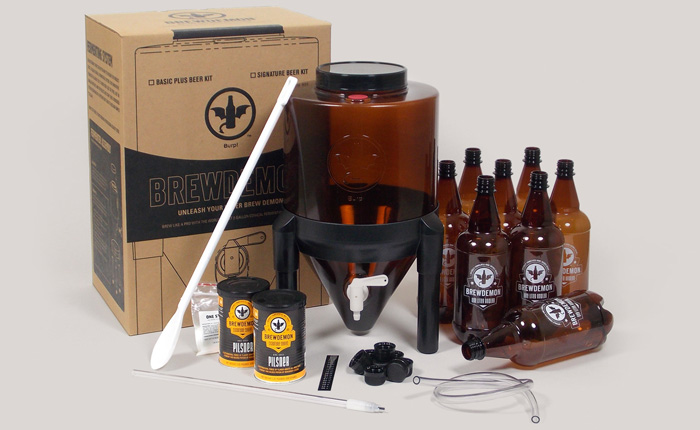
Home brewed beer has many enthusiasts in South Africa, traditionally a beer-crazy country to begin with! Here’s how and why the craze began and continues to be a favourite pursuit of the dedicated modern tippler!
Very much like other aspects of human endeavour, home brewing is the DIY upshot of present-day consumer desires. Many previously “business pursuits” are nowadays rendered simple and doable for the average homeowner, sometimes even in kit form. South Africans in 2018 are better informed and far more tech-savvy than ever before. With hindsight, as with kit cars, microlight aeroplanes, miniature saltwater aquariums or even home cheese-making, it was only a matter of time before home-brewed beer became a staple of the South African landscape. Of course, beer drinkers are often decidedly passionate about their brew, so that impetus has helped too!
Why home brew, or why not?
.jpg)
As to the “why” behind home brewing, most enthusiasts point to their preference for a chemical-free product, as well as one not limited by conformation to any particular flavour profile that a commercial brewer is obliged to maintain. This is a polite way of describing the often vociferous opinions emanating from dedicated South African beer drinkers, insistent that Brand X and Brand Y and even Brand Z all taste like mud-water! Most home brewers do it to enjoy a taste of a wholly organic, self-made beer. Not to mention the raw satisfaction of being able to say “I brewed that beer!”
At the outset of looking at home brewing, you might encounter two terms: home brew and craft brew. In a nutshell, while all home brewed beer is craft beer, by definition only that which is sold from a shop or otherwise commercialised is termed “craft beer.” Along with the rest of the world, South Africa is in the midst of a home brewing craze, and some home projects are going on to establish themselves as brand names in the market. CRAFTBRU lists popular craft brewers online, and allows visitors to look up craft beer makers in their locality too.
Top 5 pro tips on how to start brewing your own beer!
- Choose a room in the house in which to brew and - for the record - mom’s kitchen is not popular! Remember possibly the most important aspect of home brewing - CO2 kills! If you care to do the maths, you’ll realise that even one 20lt bucket of brewing beer can fill a room to saturation with CO2 in a day. Be warned!! This concentration can kill, so the prime consideration when choosing a brewing room must be that it can be constantly or at least regularly ventilated. The second consideration is that it cannot experience wild temperature fluctuations. Yeast used in brewing will suffer above certain temperatures and cease fermentation below a certain temperature, so look for a location that meets the ventilation and stable temperature range requirements.

- Buy the equipment required, either locally or online. Every brewer swears by his or her own technique, but perhaps the simplest for any novice brewer is to download some appealing recipe for beer or ale and equip themselves accordingly. An assembled home brewing kit shouldn’t cost more than a few hundred, and a few thousand at most, if you want to kick off with volume ambitions! A simplified list of goods, common to most home brewers, would read as follows:
- A large steel pot in which to cook up the initial mix
- A 20lt plastic bucket with a bottom tap to decant and a lid on top.
- A couple of stockings (pantyhose), ladles, assorted receptacles and, of course, beer bottles and crown stoppers to collect the finished product.
- Hops, malted grains (mostly barley), yeast and sugar are among the ingredients you’ll need for a typical beer recipe.
- A hydrometer.
- Following the recipe guidelines, you’ll cook up the brew and decant once done into the bucket, placing it in the pre-selected room of the house. Here you’ll add sugars and yeast as specified and seal the container, with a lid prepared. This preparation involves drilling a hole in the lid, equipping it with a rubber flange and running an 8mmm or other pipe through, to allow the CO2 to escape. The outside pipe end will sit in a container partly filled with water and placed below the level of the brew. This allows the CO2 to bubble out of the bucket, while the water prevents any air from running back up the tube into the brew. Most importantly, your gear needs to be anitised (bleached) or terilized (iodofors) before it touches the brewing beer. This applies to all goods, and various technique are available to effectively prevent brew infection.
- Hereafter follows the initial fermentation and, according to the recipe guidelines, gravity will be sampled every so often (and tremendous patience exercised!) during this stage.
- Once able to be decanted into the bottles you have sterilized and prepared, sugars are added to the brew and this will generate the fizziness of beer during its second fermentation.
There are now hosts of online resource specific to South Africa that a novice brewer can avail themselves of when starting out. How do you know whether you’ve attained a good batch? Well, let’s just say that with such distinct (and often impolite!) opinions on what makes a good beer. It’s really up to you to decide whether your home brew meets your tastes.
.jpg)
Don’t be discouraged if the first batch fails - any good brewer, home or commercial, will tell you that you’ll always learn something that makes you a better brewer next time around, no matter the only modest success or even failure of one run. Google home brewing resource, fraternitie and even beer kit and you’ll soon be on the wire to more home brewers than you can keep track of, all of which helps hugely to avoid common pitfalls and make your home brewing a success. Drink responsibly and enjoy!
Date Published: 29 August 2018